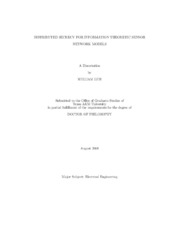| dc.contributor.advisor | Kundur, Deepa | |
| dc.creator | Luh, William | |
| dc.date.accessioned | 2010-01-15T00:12:50Z | |
| dc.date.accessioned | 2010-01-16T01:07:58Z | |
| dc.date.available | 2010-01-15T00:12:50Z | |
| dc.date.available | 2010-01-16T01:07:58Z | |
| dc.date.created | 2008-08 | |
| dc.date.issued | 2009-05-15 | |
| dc.identifier.uri | https://hdl.handle.net/1969.1/ETD-TAMU-2949 | |
| dc.description.abstract | This dissertation presents a novel problem inspired by the characteristics of
sensor networks. The basic setup through-out the dissertation is that a set of sensor
nodes encipher their data without collaboration and without any prior shared secret
materials. The challenge is dealt by an eavesdropper who intercepts a subset of the
enciphered data and wishes to gain knowledge of the uncoded data. This problem
is challenging and novel given that the eavesdropper is assumed to know everything,
including secret cryptographic keys used by both the encoders and decoders. We
study the above problem using information theoretic models as a necessary first step
towards an understanding of the characteristics of this system problem.
This dissertation contains four parts. The first part deals with noiseless channels,
and the goal is for sensor nodes to both source code and encipher their data. We
derive inner and outer regions of the capacity region (i.e the set of all source coding
and equivocation rates) for this problem under general distortion constraints. The
main conclusion in this part is that unconditional secrecy is unachievable unless the
distortion is maximal, rendering the data useless. In the second part we thus provide
a practical coding scheme based on distributed source coding using syndromes (DISCUS)
that provides secrecy beyond the equivocation measure, i.e. secrecy on each
symbol in the message. The third part deals with discrete memoryless channels, and the goal is for sensor nodes to both channel code and encipher their data. We derive
inner and outer regions to the secrecy capacity region, i.e. the set of all channel coding
rates that achieve (weak) unconditional secrecy. The main conclusion in this part is
that interference allows (weak) unconditional secrecy to be achieved in contrast with
the first part of this dissertation. The fourth part deals with wireless channels with
fading and additive Gaussian noise. We derive a general outer region and an inner
region based on an equal SNR assumption, and show that the two are partially tight
when the maximum available user powers are admissible. | en |
| dc.format.medium | electronic | en |
| dc.format.mimetype | application/pdf | |
| dc.language.iso | en_US | |
| dc.subject | information theory | en |
| dc.subject | cryptography | en |
| dc.title | Distributed secrecy for information theoretic sensor network models | en |
| dc.type | Book | en |
| dc.type | Thesis | en |
| thesis.degree.department | Electrical and Computer Engineering | en |
| thesis.degree.discipline | Electrical Engineering | en |
| thesis.degree.grantor | Texas A&M University | en |
| thesis.degree.name | Doctor of Philosophy | en |
| thesis.degree.level | Doctoral | en |
| dc.contributor.committeeMember | Halverson, Don R. | |
| dc.contributor.committeeMember | Ji, Jim X. | |
| dc.contributor.committeeMember | Song, Dezhen | |
| dc.type.genre | Electronic Dissertation | en |
| dc.type.material | text | en |
| dc.format.digitalOrigin | born digital | en |


